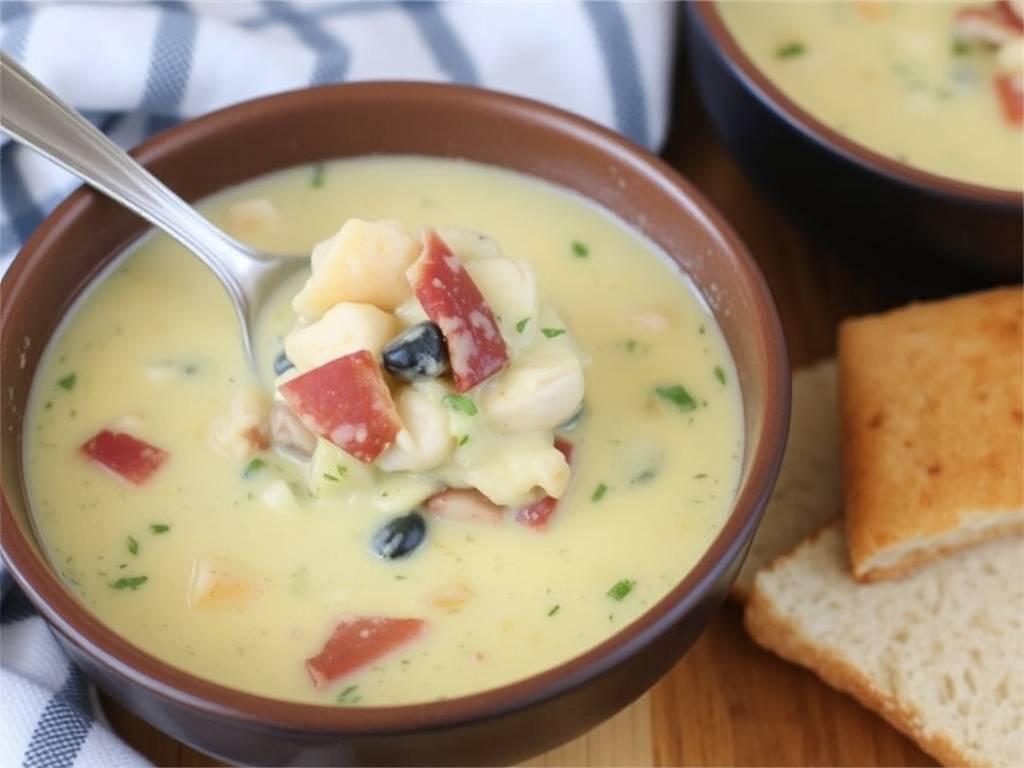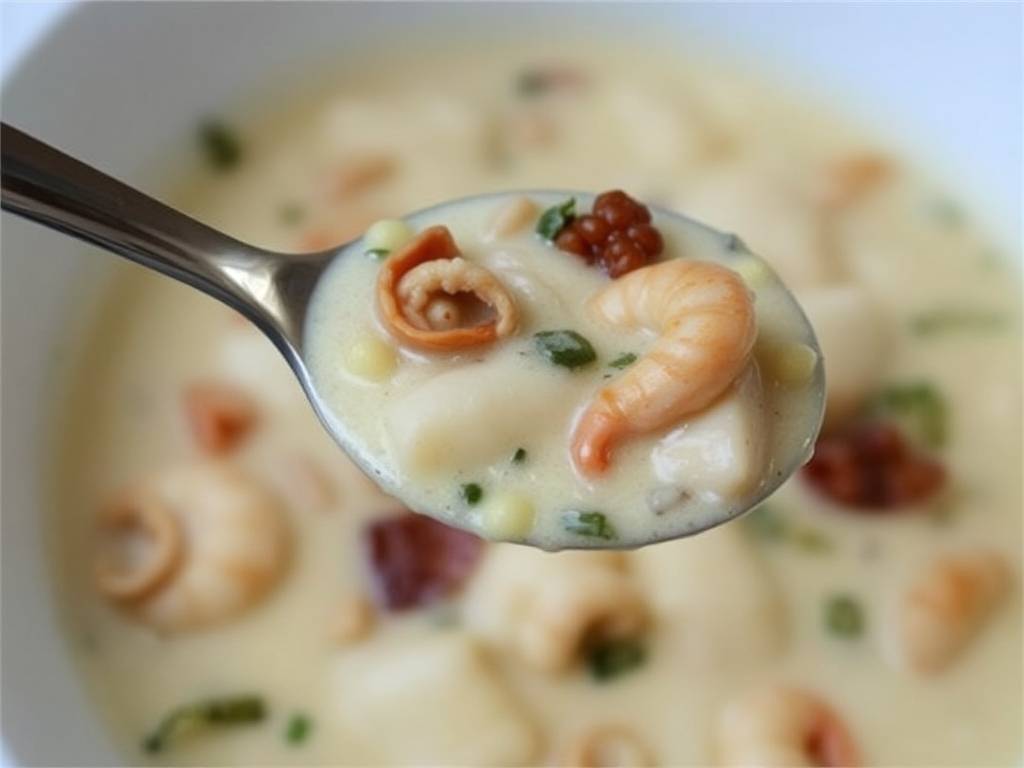A Hearty Guide to Crafting the Perfect Bacon and Seafood Chowder
There's something profoundly comforting about a bowl of chowder. It’s a hug in a bowl, a warm, creamy embrace that soothes the soul. And when you elevate that classic chowder with the smoky, savory punch of bacon and the delicate sweetness of fresh seafood, you create a culinary masterpiece that is both rustic and elegant. If you've ever wondered how to make a seafood chowder with bacon that rivals your favorite restaurant's, you've come to the right place. This comprehensive guide will walk you through every step, from selecting the best ingredients to achieving that perfect, creamy consistency.
Let's start by gathering our cast of characters. The beauty of a great chowder recipe is its flexibility, but starting with quality ingredients is non-negotiable for a truly unforgettable dish.

The Foundation: Your Ingredient List
For the ultimate bacon seafood chowder, you'll need:
- The Bacon: 6 slices of a good, thick-cut bacon. Don't use the pre-crumbled stuff; we need the rendered fat for cooking our vegetables. This is the first secret to a deeply flavorful base.
- The Holy Trinity (Aromatics): 1 large yellow onion, 2-3 celery stalks, and 2-3 carrots, all finely diced. This combination forms the aromatic backbone of your chowder.
- The Potatoes: 1.5 pounds of Yukon Gold potatoes are my top choice. They have a buttery flavor and a waxy texture that holds its shape beautifully, unlike Russets which can become mealy. Dice them into ½-inch cubes.
- The Seafood Medley: Here’s where you can get creative. A classic mix is:
- 1 pound of firm white fish (like cod, haddock, or halibut), cut into 1-inch chunks.
- ½ pound of scallops (bay or sea scallops work).
- ½ pound of raw, peeled, and deveined shrimp.
- For a special treat, you can add 8 ounces of chopped clams (with their juice!) or lump crab meat at the very end.
- The Liquid: 4 cups of a good quality seafood stock or clam juice. Using water is a missed opportunity for flavor. You'll also need 2 cups of whole milk and 1 cup of heavy cream. For a richer chowder, some recipes use half-and-half, but the combination of milk and cream gives you the best balance of flavor and texture.
- The Thickener: ¼ cup of all-purpose flour. This is the traditional way to thicken a New England-style chowder.
- The Flavor Enhancers: 3 cloves of garlic (minced), 2 bay leaves, 1 teaspoon of fresh thyme (or ½ teaspoon dried), ¼ cup of dry white wine (like Sauvignon Blanc - optional, but highly recommended), salt, and freshly ground black pepper to taste. A pinch of smoked paprika can also complement the bacon wonderfully.
- The Finish: A handful of fresh parsley, chopped, for garnish.
The Process: Building Layers of Flavor
Making chowder isn't about throwing everything into a pot at once. It's a gentle, layered process where each step builds upon the last.
Step 1: Render the Bacon In a large, heavy-bottomed pot or Dutch oven, cook the bacon over medium heat until it's crispy. This is your first critical step. The goal isn't just to cook the bacon, but to render out its fat, which we'll use as our cooking fat. Once crispy, remove the bacon with a slotted spoon and set it on a paper towel to drain. Leave about 3 tablespoons of that glorious bacon fat in the pot.

Step 2: Sauté the Aromatics Add your diced onion, celery, and carrots (this is called a mirepoix) to the hot bacon fat. Cook for 6-8 minutes, stirring occasionally, until the vegetables have softened and the onions become translucent. Now, add the minced garlic and cook for another minute until fragrant. This process, known as sweating the vegetables, unlocks their natural sugars and creates a sweet, savory foundation for your chowder.
Step 3: Create the Roux Sprinkle the ¼ cup of flour over the cooked vegetables. Stir constantly for about 2 minutes. This cooks the raw flour taste out and creates what's called a roux. The roux is the magic behind a properly thickened, non-gloopy chowder. It should look like a pasty mixture coating all the vegetables.
Step 4: Deglaze and Add Liquids If you're using white wine, now is the time to add it. Pour it in and use a wooden spoon to scrape up any browned bits from the bottom of the pot—this is called deglazing and it packs a huge flavor punch. Let the wine reduce by half, which takes about 2 minutes. Slowly pour in the seafood stock while whisking constantly. This prevents the roux from forming lumps. Once the stock is incorporated, add the diced potatoes, bay leaves, and thyme. Bring the chowder to a simmer, then reduce the heat to low, cover, and let it cook for 15-20 minutes, or until the potatoes are just tender when pierced with a fork.
Step 5: The Creamy Addition Gently stir in the whole milk and heavy cream. Be careful not to boil the chowder from this point forward, as high heat can cause the dairy to curdle. Let it heat through until it's just steaming.
Step 6: Cook the Seafood Perfectly This is the most delicate step. Season your fish, scallops, and shrimp with a little salt and pepper. Add the firmest seafood first—the white fish and scallops. Gently place them into the simmering (not boiling) chowder. Cook for 3 minutes. Then, add the shrimp and any delicate seafood like clams or crab. Cook for another 2-3 minutes, or just until the shrimp are pink and opaque and the fish flakes easily. Do not overcook the seafood! It will continue to cook from residual heat even after you turn off the stove.
Step 7: Final Touches and Serving Remove the pot from the heat. Discard the bay leaves. Taste the chowder and adjust the seasoning with salt and pepper as needed. The bacon will have already added salt, so be cautious. Crumble the reserved bacon. Ladle the hot chowder into bowls and garnish generously with the crispy bacon and fresh parsley. Serve immediately with some crusty, warm bread or oyster crackers for dipping.
Pro-Tips for the Best Homemade Seafood Chowder
- Don't Skip the Roux: This is the secret to a chowder that is creamy and thick, not thin and watery.
- Seafood Cooking Sequence: Adding the seafood last ensures it's tender and not rubbery. This is the key to a restaurant-quality seafood chowder.
- Make it Ahead: Chowder often tastes even better the next day! You can make it completely, let it cool, and store it in the refrigerator. Gently reheat it on the stove over low heat, being careful not to boil it.
- Customize Your Seafood: Don't like shrimp? Use all fish. Love clams? Add more! This is your easy bacon seafood chowder recipe to make your own.
- For a Gluten-Free Chowder: Substitute the all-purpose flour with a 1:1 gluten-free flour blend or use cornstarch (make a slurry with cold water and stir it in during the last few minutes of cooking).
Creating this creamy bacon and seafood chowder is a rewarding experience. It’s a dish that feels luxurious yet is fundamentally simple and hearty. By following these steps, you’ll master the art of building flavor and achieve a perfect, silky texture every time. So, tie on your apron, and get ready to create a bowl of comfort that will have everyone asking for seconds.






发表评论